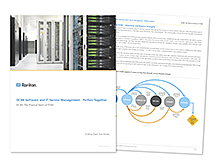The Raritan Blog
Home » Raritan Blog » Is There Room for Both DCIM and ITSM in Your Data Center?
Is There Room for Both DCIM and ITSM in Your Data Center?
Paula Alves
January 23, 2015

Information Technology is so fundamental to every business today that every organization needs to establish formal processes to ensure that IT services are continually aligned to the business, and deliver efficient and reliable support over the entire lifecycle of products and services. These processes, commonly classified as IT Service Management (ITSM), may follow a well-known model such as ITIL (IT Infrastructure Library) or, more likely, a set of internally-developed best practices.
Regardless of the chosen approach, it will typically include a database that defines the current overall IT function status accompanied by a set of ITSM processes with well- defined steps and workflow rules for planning, designing, implementing, managing and changing all components of the IT function. Many organizations have deployed ITSM software to automate and control some of these processes, especially to manage and document the workflow for changes to any component of the IT function.
At the heart of the overall IT function is the data center where an analogous discipline categorized as Data Center Infrastructure Management (DCIM) has evolved to guide the management of data center assets, their environment, and overall operations. In most ITSM software implementations, the central database repository, known as the Configuration Management Database (CMDB), normally includes the same information one may find in a DCIM database.

While many organizations will effectively use both ITSM software and DCIM software independently, a company wishing to manage both IT assets and data center facilities together can be more effective if they use the same database to effectively communicate and share information and processes. This is where the value of integration of ITSM and DCIM comes into play.
Several organizations are already integrating their Raritan DCIM software with their ITSM software and operational support elements, e.g. CMDB, Service Desk, change ticketing systems, and workflow engines. Requested changes to the DCIM system information flow to and back from the ITSM system. A single, accurate database of all the collected IT asset data is stored and shared. This integration provides both operational consistency in handling all change requests and significant operational efficiency and reliability.
This is just one example of how integration has helped organizations in their quest for DCIM solutions that can help better manage the asset, change, and monitoring functions within their data center. However, it does demonstrate that there is room for both DCIM and ITSM in your data center.
 To learn more about how the integration of DCIM and ITSM can help you, download the DCIM Software and IT Service Management - Perfect Together whitepaper today.
To learn more about how the integration of DCIM and ITSM can help you, download the DCIM Software and IT Service Management - Perfect Together whitepaper today.
Other Blog Posts
- The Rapid Growth of AI and the Use of Raritan PDUs to Meet Higher Power Demands
- Posted on October 11, 2023
- Data Center Report Fewer Outages, But Downtime Still Costly
- Posted on September 20, 2023
- Survey: Energy Usage and Staffing Shortages Challenge Data Centers
- Posted on September 20, 2023
- Raritan Secure Switch: Secure NIAP 4.0 Compliant Desktop KVM
- Posted on September 20, 2023
- The Midwest is a Hot Market for Data Centers: How the New Generation of Intelligent Rack PDUs Can Save Cloud Giants Uptime and Money
- Posted on September 7, 2023
Subscribe
Upcoming Events
- AFCOM Data Center World
- April 15 – 18 • Walter E Washington Convention Center - Washington, DC
- Advancing Data Center Construction West 2024
- May 6 – 8 • Salt Lake City, UT
- Net Zero Data Center
- May 16 – 17 • Dallas, TX
- 7x24 Exchange Spring
- June 9th • JW Marriott Orlando Grande Lakes
Latest Raritan News
- Legrand Certifications and Process Controls Provide Confidence in Information Security for Network-Connected Devices in Data-Related Applications
- Posted on April 1, 2024
- Legrand Releases Version 4.0 of Raritan’s Industry-Leading Secure KVM Switches, Raising Bar for Secure Desktop Access
- Posted on July 31, 2023
- Legrand Revitalizes Data Center Sector with Two Revolutionary Intelligent Rack PDUs
- Posted on May 1, 2023
- Raritan Reveals The MasterConsole® Digital Dual KVM Switch
- Posted on February 18, 2021
- Legrand Data, Power and Control Division Announced as Finalist in Six Categories at DCS Awards 2020
- Posted on November 9, 2020